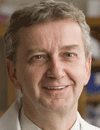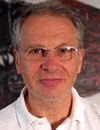09:30 |  | Keynote Presentation 5-Hydroxymethylcytosine in Development and Cancer
Gerd Pfeifer, Professor, City of Hope Medical Center, United States of America
5-hydroxymethylcytosine is a modified DNA base created by enzymatic oxidation of 5-methylcytosine. Studies of 5-hydroxymethylcytosine in cancer and in the mouse brain are beginning to provide information on the specific distribution and potential function of this novel DNA base. |
|
10:30 | Coffee Break and Networking in the Exhibition Hall |
|
Chromatin Mechanism in Epigenetic Marking |
| |
11:15 | Population Epigenomics of the Drosophila Y Chromosome
Bernardo Lemos, Assistant Professor, Harvard School Of Public Health, United States of America
We have recently uncovered Y-linked regulatory variation: the quantitative effects that polymorphic tracts of Y-linked chromatin exert on autosomal and X-linked genes. Here we combine several datasets to provide insights into the mechanisms by which Y chromosomes modulate epigenetic states. |
11:45 | Reading and Writing Histone Marks by the MYST-ING Tumor Suppressor Complexes
Jacques Cote, Professor, Laval University, Canada
I will present our recent work on human histone acetyltransferase complexes and how cross-talks between histone marks occurs through different subunits of these complexes to regulate gene expression, genome stability and cell fate. |
12:15 | Lunch Break and Networking in Exhibition Hall |
13:30 | Poster Viewing Session |
14:15 | The Histone Demethylase LSD1/KDM1 is a Master Regulator of the Stem Cell Fate
David Katz, Assistant Professor, Emory University, United States of America
Histone modifications, such as H3K4me2, may function in maintaining transcriptional states through cell division. This talk will focus on the role of the histone demethylase LSD1 in mammalian stem cell populations reprogramming H3K4me2 to enable changes in cell fate. |
14:45 | Targeting Leukemia Oncogene Expression with Bromodomain Inhibitors
Christopher Ott, Research Fellow, Harvard School of Public Health, United States of America
Bromodomain inhibitors disrupt the association of chromatin-binding proteins with transcriptionally active regions of the genome. We have developed JQ1, an inhibitor of BET bromodomains; JQ1 induces a dramatic and selective decrease in oncogene expression in leukemia cells. |
15:15 | Coffee Break and Networking in the Exhibition Hall |
16:00 | Chemical Modulation of Chromatin Structure
Jun Qi, Lead Scientist, Dana Farber Cancer Institute, United States of America
This presentation will describe the development of chemical modulators of lysine acetylation for cancer research and cancer medicine. |
|
Nuclear Dynamics and Long-range Control |
| |
16:30 | Noncoding RNAs in Chromatin Regulation
Claes Wahlestedt, Professor, University Of Miami, United States of America
Much of the mammalian genome is transcribed into long and small noncoding RNAs of different categories. This lecture will primarily be concerned with long noncoding RNAs which regulate gene expression through several distinct mechanisms involving chromatin regulator protein complexes. Implications for chromatin related small molecule drug discovery will be discussed. |
17:00 | The Epigenetics of Genomic Stability and DNA Repair
Brendan Price, Division of Genome Stability and DNA Repair, Dana Farber Cancer Institute, United States of America
DNA repair requires remodeling of the local chromatin architecture. Chromatin remodeling at sites of DNA damage requires both dynamic regulation of histone modifications and exchange of histone variants. These epigenetic changes then function together to direct assembly of a chromatin template which is an efficient substrate for the DNA repair machinery. |
17:45 | Round Table Discussions in the Exhibition Hall |
19:00 | Close of Day One |

